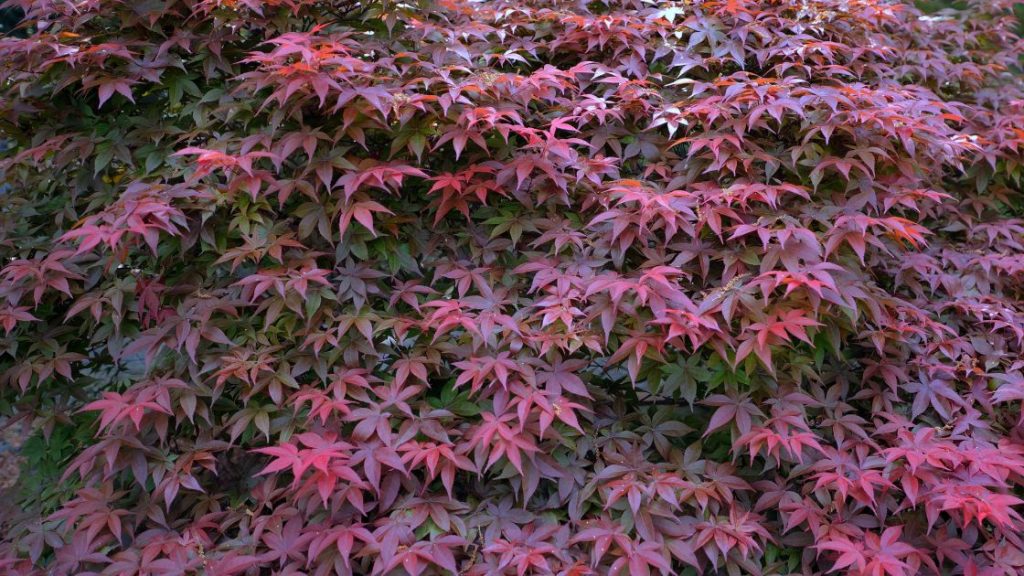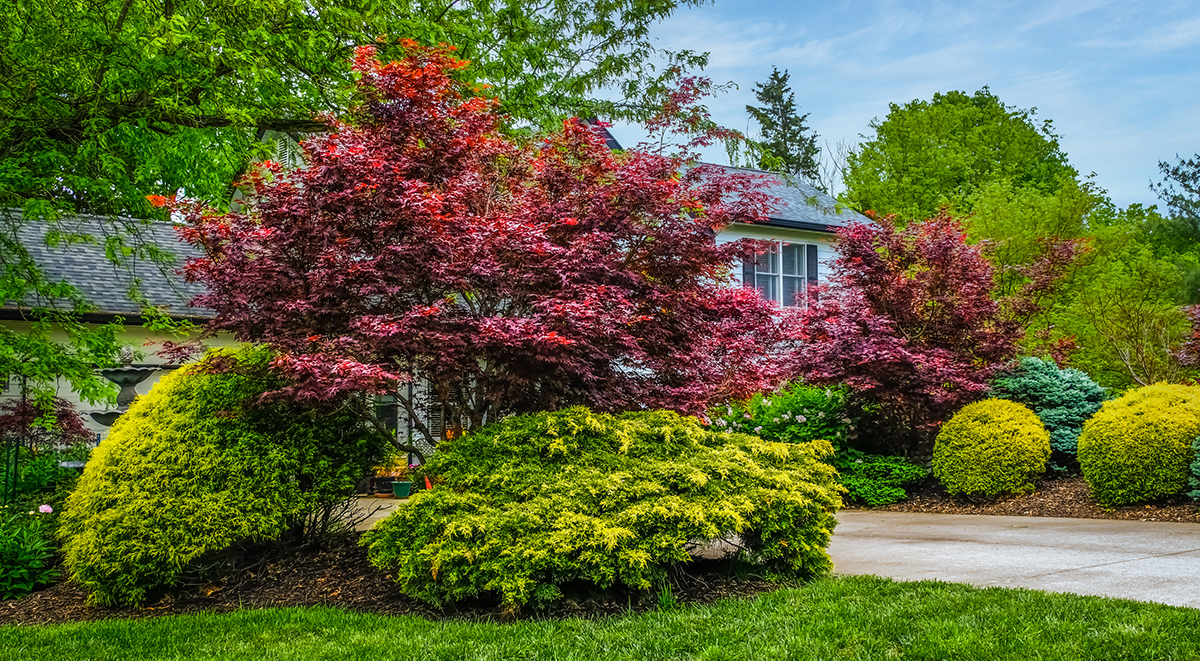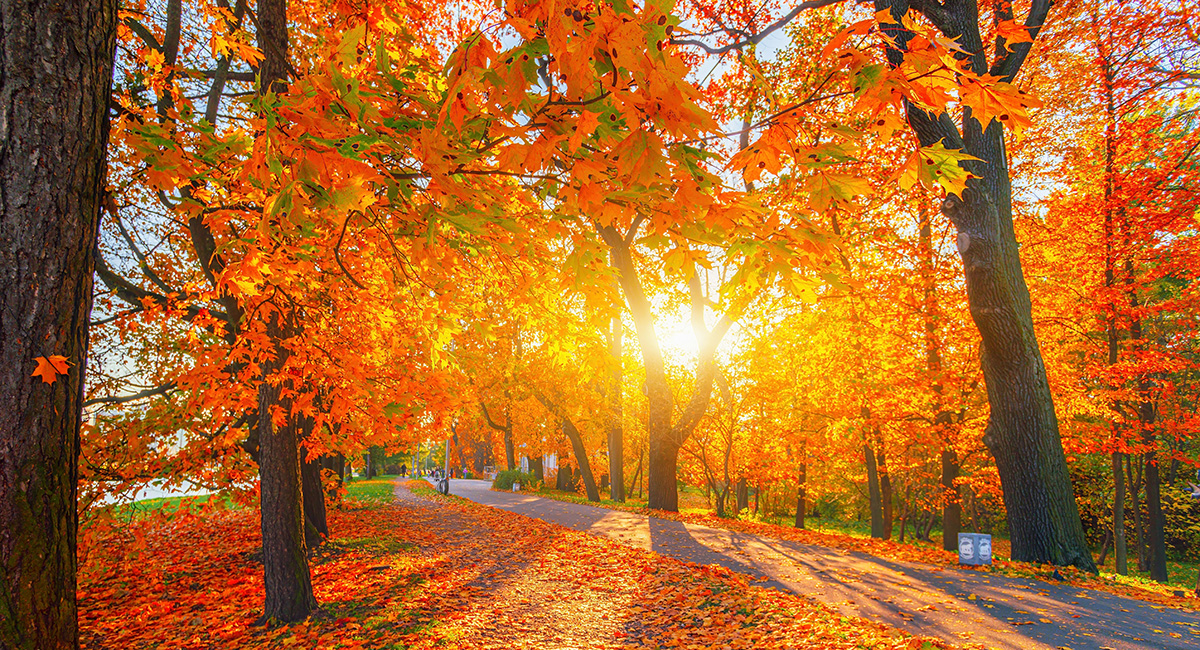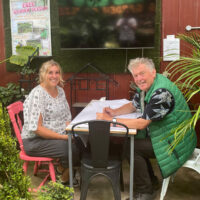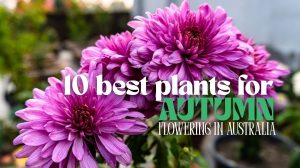Choosing the right Japanese Maple:
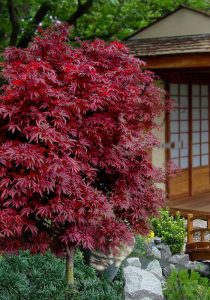 One of the popular varieties of Japanese Maples is the Shaina. It has quite beautiful red stems. It works really well with modern architecture. In winter, when it has no leaves, its beautiful red stems still give you colour. Then in spring you get lovely green leaves set against the red stems. As you go into late summer you start to get soft pinks and oranges through it. Then when you get right into autumn, you get sort of oranges and reds and pinks and yellows. It’s a very, very colourful, interesting tree with great variety throughout the seasons. This makes it very popular in Japanese style gardens, not surprisingly.
One of the popular varieties of Japanese Maples is the Shaina. It has quite beautiful red stems. It works really well with modern architecture. In winter, when it has no leaves, its beautiful red stems still give you colour. Then in spring you get lovely green leaves set against the red stems. As you go into late summer you start to get soft pinks and oranges through it. Then when you get right into autumn, you get sort of oranges and reds and pinks and yellows. It’s a very, very colourful, interesting tree with great variety throughout the seasons. This makes it very popular in Japanese style gardens, not surprisingly.
The Shaina is a lovely compact form of the Japanese Maple. If you are after a small Japanese Maple, that isn’t a a weeping style, this is a great choice. It’s only going to grow 2.5 – 3.0 metres tall. It has a beautiful maroon foliage with lovely fine dissected leaves. In autumn it produces the most amazing iridescent red. You can buy low grafted varieties or you can buy varieties that are four or five foot tall with a lovely little red ball on top.
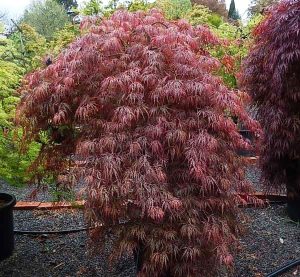 Another popular variety is the Hana Matoi. It has very fine delicate foliage with lovely little patches of pink through it. It’s a fairly slow-growing variety. Being a little bit more delicate a variety you wouldn’t put a Hana Matoi in an overly exposed spot or a really hot windy spot. You’d keep it somewhere a little bit sheltered, maybe a bit of an easterly position out of the hot afternoon sun.
Another popular variety is the Hana Matoi. It has very fine delicate foliage with lovely little patches of pink through it. It’s a fairly slow-growing variety. Being a little bit more delicate a variety you wouldn’t put a Hana Matoi in an overly exposed spot or a really hot windy spot. You’d keep it somewhere a little bit sheltered, maybe a bit of an easterly position out of the hot afternoon sun.
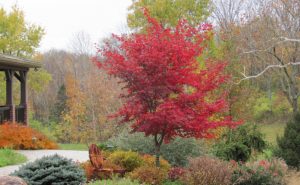 The Shindeshojo is a lovely fine Japanese Maple. It has a delightful bright coloured foliage with really interest colours. It has a finer leaf than a normal Japanese Maple. It won’t grow overly large. It gives you both absolutely brilliant spring colour and lovely autumn colour as well.
The Shindeshojo is a lovely fine Japanese Maple. It has a delightful bright coloured foliage with really interest colours. It has a finer leaf than a normal Japanese Maple. It won’t grow overly large. It gives you both absolutely brilliant spring colour and lovely autumn colour as well.
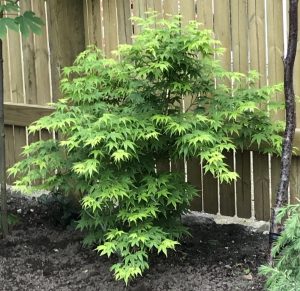 The Nishiki Fountain is a different kind of weeping Japanese Maple. Most weepers have a fine dissected leaf. But this has a normal Japanese maple leaf that hangs straight down. This makes it quite a really, really unusual maple. It has the most amazing autumn colours, giving you red, orange and yellow, every colour almost all at once. There’s a whole kaleidoscope of colour in autumn with the most interesting shape and interesting leaf, it really is a most unusual and quite a hardy weeping Japanese Maple.
The Nishiki Fountain is a different kind of weeping Japanese Maple. Most weepers have a fine dissected leaf. But this has a normal Japanese maple leaf that hangs straight down. This makes it quite a really, really unusual maple. It has the most amazing autumn colours, giving you red, orange and yellow, every colour almost all at once. There’s a whole kaleidoscope of colour in autumn with the most interesting shape and interesting leaf, it really is a most unusual and quite a hardy weeping Japanese Maple.
The Atropurpureum Japanese Maple comes in both upright and weeping form (see images below). It is quite small with a deep purple foliage that turns into a gorgeous red in Autumn. Many people love it as a feature tree. It does best if you plant it in partial shade or full sunlight in a moist but well drained soil.
Another gorgeous purple variety of Japanese Maple is the Emporer 1. It’s one of the best, upright, non – weeping varities for colour all year round. It has a quite large leaf, that is a dark, almost black like purple that in spring goes through various shades of purples and reds into brownish reds in summer through to an amazing scarlet red in Autumn.
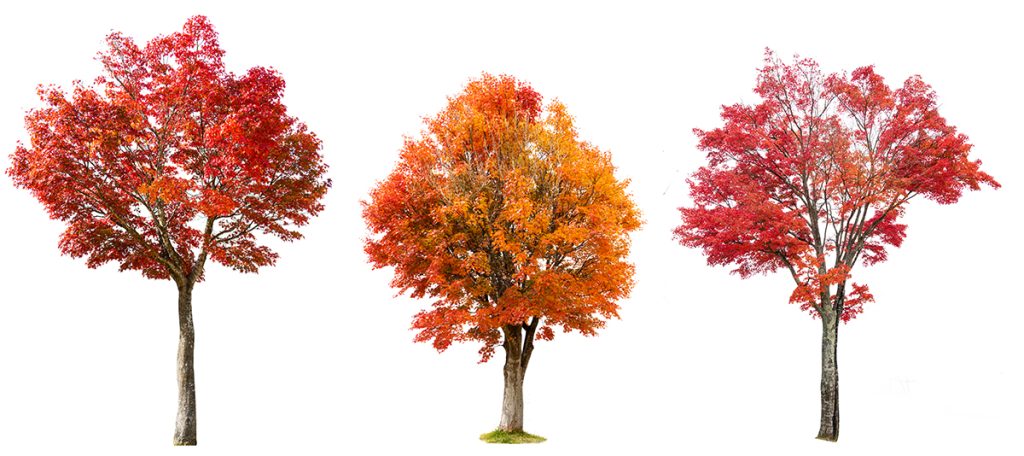
If you look closely at some Japanese Maples you may notice they have 2, 3, 4 or even 5 different stem sections. What this means is that the person who grafted it, did it four or five times.
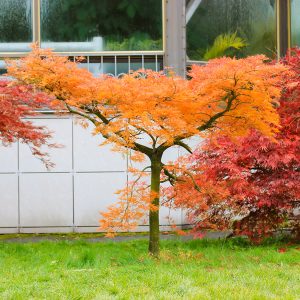 It can be quite a lot of work to graft them and it can be very difficult. But doing this can produce the exact shape and style of plant the grafter wanted. For example, they might do it to create a very, very broad head on one or to graft an older head onto a younger stem. This kind of skill takes years to develop and practice. So when you see a Japanese Maple at a nursery for several hundred dollars remember it might be anywhere between 8 – 10 years old. And it would have taken a lot of work and time in grafting and care to get the plant looking like it does when you see it in the nursery.
It can be quite a lot of work to graft them and it can be very difficult. But doing this can produce the exact shape and style of plant the grafter wanted. For example, they might do it to create a very, very broad head on one or to graft an older head onto a younger stem. This kind of skill takes years to develop and practice. So when you see a Japanese Maple at a nursery for several hundred dollars remember it might be anywhere between 8 – 10 years old. And it would have taken a lot of work and time in grafting and care to get the plant looking like it does when you see it in the nursery.
The Best Place for Your Maples
When choosing Japanese Maples, it’s important to think about where you are going to plant it and how big you wanted it to grow. This can help decide whether you want a weeping variety or a straight up one. If for example you had a roof overhang or something and you didn’t want your maple to grow more than 5 or 6 feet tall, you would probably want a weeping variety. Or if you wanted to grow one upwards but not too big, you can get a compact variety like the Shaina. If you have a really big garden and you wanted to shelter some ferns or other delicate plants then you can use one of the larger growing varieties of Japanese Maple.
Choosing a colour is also an important consideration before purchase. Japanese Maples can come in all sorts of colours – pinks, reds, oranges and purples – there are some really deep purples available that are almost black. Some people like to plant them in contrasting colours, with say one green and one red. Alternatively you can just choose to contrast the shades of them with a mix of darker ones and lighter ones. There a few purple varieties which stay purple in spring, summer and through to autumn, such as the Bloodgood and the Atropurpureum.
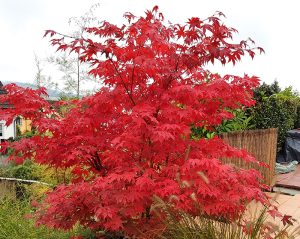 If you really want a spectacular show in Autumn you can’t go past the Osakazuki Japanese Maple (left). It doesn’t grow too tall but it does grow quite wide. It has large leaves that just seem to float on it. In summer it’s a lovely rich green but when autumn comes it colours for maybe 3-4 weeks with the most amazing, intense, brilliant scarlet red.
If you really want a spectacular show in Autumn you can’t go past the Osakazuki Japanese Maple (left). It doesn’t grow too tall but it does grow quite wide. It has large leaves that just seem to float on it. In summer it’s a lovely rich green but when autumn comes it colours for maybe 3-4 weeks with the most amazing, intense, brilliant scarlet red.
If you take care of your Japanese Maple it will give you many years of joy. Some people say that they can’t take hot sun, but that’s not quite true. If you do have a really hot sunny spot in mind for your Japanese Maple make sure you talk to your local nursery about choosing one of the hardier varieties.
 Another issue in Melbourne is that we have a lot of hard clay soil. If you dig a hole for your Japanese Maple that is only the size of the pot it was in and plant it, it won’t do well because the roots are not overly aggressive or tough and they can’t spread through the clay. In hot windy weather they burn and shrivel.
Another issue in Melbourne is that we have a lot of hard clay soil. If you dig a hole for your Japanese Maple that is only the size of the pot it was in and plant it, it won’t do well because the roots are not overly aggressive or tough and they can’t spread through the clay. In hot windy weather they burn and shrivel.
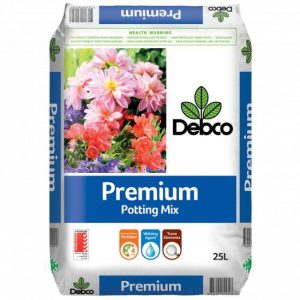 So the secret is more in how you plant it than where you plant it. Ideally, dig a nice big, very wide hole. Fill it with a good quality potting mix, not a cheap one. (You spent a lot on the tree, don’t scrimp on what you plant it in.) Mix in some good compost and soil. (You can even use something like Nature’s Soil which has large particles in it that create air spaces making it open so the roots get moisture and can breathe.)
So the secret is more in how you plant it than where you plant it. Ideally, dig a nice big, very wide hole. Fill it with a good quality potting mix, not a cheap one. (You spent a lot on the tree, don’t scrimp on what you plant it in.) Mix in some good compost and soil. (You can even use something like Nature’s Soil which has large particles in it that create air spaces making it open so the roots get moisture and can breathe.)
But the secret is to make the hole really nice and wide so the Japanese Maple’s roots can spread out. With the right soil mix in the ground, if you water it well, the roots can really take up lots of moisture and that will help them survive the hot summer days.
 Of course, if you get a really hot spell the other secret is to just water it well. Daily is fine in summer, even twice a day on a real scorcher. With enough water they’ll survive the sun and hot winds. If you are still worried you can always use a soil wetting agent to make the watering more effective.
Of course, if you get a really hot spell the other secret is to just water it well. Daily is fine in summer, even twice a day on a real scorcher. With enough water they’ll survive the sun and hot winds. If you are still worried you can always use a soil wetting agent to make the watering more effective.
The other secret to a long-lived healthy Japanese Maple is the right fertiliser. Something all-purpose like Osmocote is great, about every 6-8 weeks is ideal. But also adding a dash of dolomite lime is important because lime is water soluble and if you are watering it a lot you are washing all the lime out of the soil. Without the calcium in the lime, the plant can’t process all the other nutrients it gets from the soil and the fertiliser.
In Closing
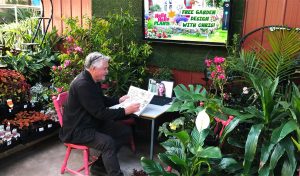 So this is almost all you ever needed to know about Japanese Maples in one article. If you are still unsure about which variety to choose for your garden or exactly where to plant which one, don’t forget we have a FREE Garden Design service where we can take you through an entire design for a garden and help you choose the right plants to make your garden gorgeous. Click here to book.
So this is almost all you ever needed to know about Japanese Maples in one article. If you are still unsure about which variety to choose for your garden or exactly where to plant which one, don’t forget we have a FREE Garden Design service where we can take you through an entire design for a garden and help you choose the right plants to make your garden gorgeous. Click here to book.




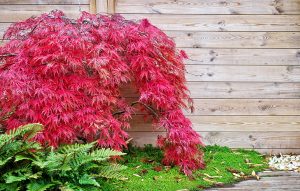 If you’ve ever dug up a big, fully grown Japanese Maple, you might be surprised to see how small their root systems are compared to other trees. Because they don’t have an overly large root system, you can plant them in courtyards or other small spaces, really quite close to buildings.
If you’ve ever dug up a big, fully grown Japanese Maple, you might be surprised to see how small their root systems are compared to other trees. Because they don’t have an overly large root system, you can plant them in courtyards or other small spaces, really quite close to buildings.



